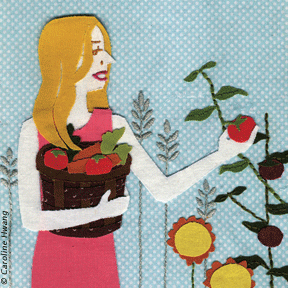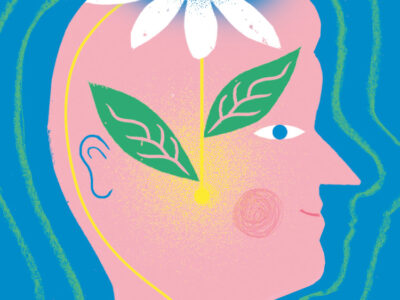
Class of ’83 | Lots of people come down with stomach ailments after a trip abroad, so Alice Bast’s illness after a jaunt in Mexico probably didn’t raise much alarm—until it didn’t go away.
“I lost 25 pounds, had a full-term stillbirth, three miscarriages, and a daughter who weighed only two pounds,” says Bast C’83. “I thought I had cancer.”
Over a six-year period, she consulted more than 20 doctors, but to no avail. The physicians “were just treating the symptoms” without coming any closer to the root of the problem. Then a veterinarian friend suggested that Bast get a blood test similar to one used on dogs to detect an intolerance for wheat. She got the test, and a diagnosis. She had celiac disease, an autoimmune disorder that renders its victims unable to process the gluten protein found in wheat, rye, and barley.
When someone with celiac ingests gluten, it triggers the immune system to damage the inner intestinal lining, interfering with the absorption of nutrients. This leads to malnourishment, and explains Bast’s significant weight loss and fertility struggles. While an estimated 30 to 40 percent of Americans have the gene predisposing them to celiac, one out of every 132 have the disease, whose symptoms include fatigue, bloating, and diarrhea. With such unspecific warning signs, a staggering number of celiac sufferers—roughly 2.5 million people, according to the University of Chicago’s Celiac Disease Center—go undiagnosed.
Which is what prompted Bast to dive into research on the illness. Having spent most of her professional life in business development for medical-device companies, she worked as the principal investigator on a small-business innovation research grant application (“Novel Educational Aids for Celiac Disease”) from the National Institutes of Health and co-authored an article for the Journal of Practical Gastroenterology titled “Celiac Disease and Reproductive Health Issues.” And in 2003 she founded the National Foundation for Celiac Awareness (NFCA), whose overall goal is to educate patients and professionals in the fields of health care and food.
David Metz, a Penn professor of medicine who specializes in digestive issues, says he has “definitely noticed increased awareness [of celiac] among gastroenterologists,” adding: “The way forward for a lot of diseases will be advocacy groups working directly with physicians to raise awareness. And this is an example of one that works.”
On the dining side of the equation, the prevalence of grains in many dishes has prompted an increasing number of chefs to create safe, gluten-free meals for celiac patients. After all, the only treatment for celiac is diet change.
“I went on a gluten-free diet and I felt like my life was being renewed,” says Bast. “My health was completely restored in just two weeks.”
So she pioneered a program working with Philadelphia’s top restaurateurs, including Georges Perrier and José Garces. Free webinars teach chefs how to cook savory gluten-free meals so celiac sufferers don’t have to give up dining out. So far, 67 restaurants, supermarkets, caterers, and food-service providers have completed the course in Pennsylvania alone, thanks to Bast’s high-energy efforts.
“She wanted me to participate in the fundraising … and change my menu a little. And I agreed,” a smiling Perrier testified in a promotional video for the Philadelphia Award, which Bast took home in 2010. “I could not say no,” Perrier added, “because it’s difficult to say no to someone who won’t take no for an answer.”
A key ingredient to winning the award was undoubtedly the success of the NFCA’s most popular event, Appetite for Awareness. The giant vendor fair pairs doctors and chefs so that each can learn about how to approach treatment of celiac. In addition to Philadelphia, Bast has organized similar fairs in New York, Boston, San Francisco, St. Louis, and at CNN’s headquarters in Atlanta.
“We get the hospitals engaged in treating celiac disease,” says Bast. “It’s a really fun event. A lot of these doctors were just treating the symptoms.” The food’s not bad either: “We had grilled-cheese sandwiches on really good [gluten-free] bread. People miss the simple things!” Her work with local hospitals and chefs has helped establish Philadelphia as the first major “gluten-free neighborhood,” where celiac patients can easily grocery shop or dine out without risking their health.
Over the years, Bast’s dedication to her cause has garnered national attention. Her story has graced the pages of Good Housekeeping, Newsweek,and USA Today, and she recently traveled to Oslo, Norway to speak at an international symposium on celiac and advocate for awareness.
“It was pretty fascinating,” she says. “I got to experience what it was like to deal with celiacs in other countries.”
Asked to recommend her own favorite gluten-free meal, Bast responds: “I like healthy, fresh ingredients. A really good piece of salmon. Mango, cilantro, and avocado, a little bit of hot peppers. I also like recipes with quinoa, and I’ve been using nuts and things. I try to be really creative with fresh ingredients.”
Maybe celiacs don’t have it so bad.
—Katie Siegel C’13




